Lynn Garrison
Lynn Garrison (born 1 April 1937) is a Canadian pilot and political adviser. He was a Royal Canadian Air Force fighter pilot in the 403 City of Calgary Squadron, before holding jobs as a commercial pilot, film producer, director and mercenary. Garrison has also accumulated a substantial collection of classic aircraft, flying many of these as well as organising their restoration and preservation.
Lynn Garrison | |
|---|---|
 Lynn Garrison in the cockpit of his Corsair N693M at the National Air Races in Reno, Nevada, 1966 | |
| Born | April 1, 1937 |
| Allegiance | |
| Service/ | |
| Years of service | 1954–1964 |
| Rank | Wing Commander |
| Unit | 403 City of Calgary Squadron |
| Awards | Paul Tissandier Diploma |
During the 1980s and 1990s, Garrison served in various political capacities, such as being an adviser to Haitian President Raoul Cédras and serving as Haitian Consul to the United States between 1992 and 2010. In his latter years, he has been increasingly active as an author as well as various charitable concerns. With regard to flying, Garrison is known for his oft-repeated comment, "If it has fuel and noise, I can fly it."
Military career

Throughout the Second World War, Garrison's family hosted student pilots from the British Commonwealth Air Training Plan during their fortnightly leave. Contact with these pilots stimulated Lynn's interest and by the age of four, he had decided he would be a pilot. During April 1946, his parents purchased a ride for him in an ex-RCAF Cessna AT-17 operated by Kepler Aviation at Calgary International Airport.
At the age of 17, Garrison joined the RCAF and trained at the RCAF Officer Selection Unit (Ontario) and Course 5411, 4 Flying Training School (RCAF Station Penhold, Alberta). During October 1954, the Beechcraft T-34 Mentor was introduced to RCAF service as an intended replacement for the Harvard; Garrison was amongst 48 students who flew it during trials, which led to the T-34 being dropped by the RCAF after only a few months. Garrison advanced to 2 Advanced Flying School (Portage la Prairie, Manitoba) for jet aircraft training (in the Canadair CT-133 Silver Star). Garrison received his wings on 6 April 1955, making him the youngest "winged pilot" in the RCAF since the Second World War, a record that still remains.
After completing additional training in the F-86 at RCAF Station Macdonald, Manitoba, Garrison returned to 403 City of Calgary Squadron, where he served for ten years from 1954 until 1964, during which time he was occasionally seconded to other units. On 1 April 1958, Garrison piloted the last Canadian military flight of the Hawker Sea Fury. The specific aircraft, WG565, is now displayed in Calgary.
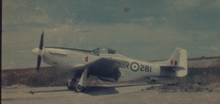
During April 1958, RCAF Mustang 9281, 44-73973, was retired from service. One year later, while coordinating an air show at McCall Field, Calgary, Garrison repainted 9281 for display. Photographs of this specific paint job have been used as proof the RCAF used RAF Roundels as late as 1959.

On 4 July 1964, Garrison captained the RCAF's final flight of the Avro Lancaster with Flight Lieutenant Ralph Langemann as co-pilot. Specially authorized by Minister of National Defence, Paul Hellyer, the flight was complicated by the fact that Garrison had never flown a Lancaster and had broken his ankle the previous day. It displayed at the Calgary International Air Show, an event created and coordinated by Garrison. After the flight, Garrison purchased the aircraft, KB-976, which is now on display in Kermit Weeks' Fantasy of Flight collection in Florida.[1]
In his classic, Fighter Command Air Combat Claims, 1939–45 (1939–1940), John Foreman commented on the question of pilot temperament and ability. Foreman observed that Garrison had remarked, "In every squadron there were, perhaps, four or five pilots who exuded confidence. They knew that they were going out to shoot. The rest knew sub-consciously, that they would make up the numbers, mill about, and get shot at".[2]
Post-military career
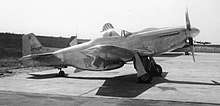

In 1960, Garrison obtained a contract to ferry 75 ex-RCAF P-51 Mustangs to new owners in New York. Milt Harradence took time off from his law practice to accompany Garrison on the trips. Flying mainly without radios, they navigated by following the Canadian Pacific Railway tracks eastward. Harradence and Garrison acquired two Mustangs as part of their compensation and registered them RCAF 9221 44-74435"CF-LOR" and RCAF 9223 44-74446 "CF-LOQ";[3] the first of their type registered in Canada.
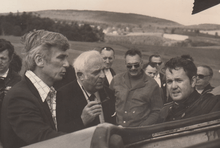
In 1962, Garrison served with 115 Air Transport Unit of the United Nations Emergency Force (UNEF), on the Sinai Peninsula, where he flew de Havilland Otters and Caribous. While with 115 ATU he acted as Under-Secretary-General of the United Nations Dr. Ralph Bunche's pilot.[4]
During the sixties, Irving P. Krick & Associates operated a successful cloud seeding operation in the area around Calgary, Alberta, utilizing four Harvards to disperse silver iodide into the atmosphere in an attempt to reduce hail damage. For several years, Garrison, Ralph Langeman and Stan McLeod, all ex-members of the RCAF's 403 Squadron, spent their summers flying hail suppression. The Alberta Hail Suppression Project is continuing with C$3 million a year in funding from insurance companies to reduce hail damage in southern Alberta.[5]
During 1963, Garrison, with authorization from Paul Hellyer and the help of RCAF 121 Search & Rescue Unit, assisted with the salvage of a Vought OS2U Kingfisher from Calvert Island, which had crashed during a ferry flight to Alaska during the Second World War. It was brought to Calgary, restored by Vought Aeronautics and donated by Garrison to the North Carolina Battleship Commission where it is now displayed on the stern of the USS North Carolina, one of the surviving Second World War battleships.
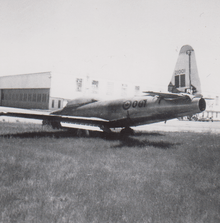
In 1963, Garrison purchased the first Canadair CT-133 21001 for his classic aircraft collection. It is now displayed on a pylon near the old site for Edmonton, Alberta's Municipal Airport.
In June 1964, Garrison bought two Canadair Sabre Golden Hawks aircraft from Canada. Plans for Bob Hoover to perform air show routines in one were derailed by the unavailability of the ejection seat's explosive charges and insurance. Registered as CF-AMH, it was flown by Harradence and Garrison. Garrison flew the other Sabre (RCAF 23454) before its sale to Russell O'Quinn's Flight Test Research in Long Beach, California.
In 1964, Garrison established the Air Museum of Canada.[6] Prior to the creation of the Museum, Garrison had accumulated a personal collection of 45 classic aircraft including:
- Airspeed Oxford
- Avro Lancaster
- Avro Anson
- Avro Canada CF-100 Canuck
- Bristol Fairchild Bolingbroke
- Canadair F-86 Sabre
- CaudronLuciole
- Consolidated B-24 Liberator
- de Havilland Mosquito
- de Havilland Vampire
- de Havilland Tiger Moth
- de Havilland Canada DHC-1 Chipmunk
- Fairchild PT-19
- Fairey Battle
- Fleet Finch
- Fokker D.VII
- Fokker Dr.I
- Hawker Hurricane
- Lockheed T-33
- Morane-Saulnier MS.230
- North American B-25 Mitchell
- North American BT-9Yale
- North American T-6 Texan Harvard
- North American P-51 Mustang
- Pfalz D.III
- Royal Aircraft Factory S.E.5
- Stampe-Vertongen SV.4
- Supermarine Spitfire
- Sikorsky H-5
- Vought F4U Corsair
- Vought OS2U Kingfisher
- Westland Lysander
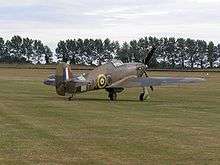
In 1963, Garrison acquired a number of Hawker Hurricanes from farmyards in Alberta and Saskatchewan for his collection. He planned to create Canada's first flying aviation museum but could not generate interest. One of these now flies as G-HURI while Hurricane 5389 is now under the stewardship of the Calgary Mosquito Aircraft Society and is under restoration in Wetaskiwin, AB. During December 2013, Bonham's Auction House offered one of Garrison’ Hurricanes for sale, valuing it at between $2,000,000 and $3,000,000.[7]
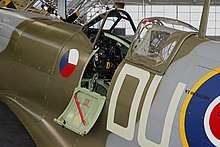
In 1963, Garrison purchased Supermarine Spitfire VB AR-614 from Britain's Ministry of Defence and had it transported to Calgary. It later joined Paul Allen’s Flying Heritage Collection in Seattle, Washington.
After 50 years in storage, on 11 August 2012, Garrison’s ex-Spartan Air Services PR.35 Mosquito (RS700 CF-HMS) was transferred to the Bomber Command Museum in Nanton, Alberta, for restoration by the Calgary Mosquito Aircraft Society with half of the $1,650,000 funding provided by the City of Calgary.[8]
Garrison became involved in air show promotion with the Calgary International Air Show in 1963, 1964 and 1965. In 1966, he created the Los Angeles International Air Show which ran until 1969. Garrison was also involved in the Irish International Air Shows of 1970 and 1971, and the 1968 Las Vegas International Exposition with Danny Kaye.
Located in Calgary, the Glenbow Museum, Canada's largest, was formed in 1966, when Eric Harvie donated his vast collection to the people of Alberta. Harvie had served during the First World War with Garrison’s father. The museum included a manikin with Garrison’s flying suit and helmet in its permanent "Warriors: A Global Journey Through Five Centuries" collection. In 1964, Harvie purchased a surplus RCAF Sikorsky H-5 S-51 helicopter for Garrison's collection; it remains on display in Calgary.
Garrison relocated to Los Angeles during 1966 and incorporated the American Aerospace & Military Museum, Inc. with Walker Mahurin, Mira Slovak, Chuck Lyford and Mickey Thompson on the board. Mahurin obtained displays from the USAF, the first being a HGM-25A Titan 1 missile. Ed McMahon, a former Marine Corsair pilot, and Johnny Carson’s nightly TV sidekick, was involved with the project. As a result, Carson heard about the missile and used it in a joke, one night, commenting on “people who forgot luggage at motels, but here was a guy who forgot a Titan Missile!” The resulting uproar saw the USAF retrieve their property.[9]
Between 1965 and 1969, Garrison was president of Craig Breedlove & Associates. Breedlove held the World Land Speed Record five times in 1965 with a top speed of over 601.1 miles per hour. During 1968, Garrison started a deal that saw Utah's Governor, Cal Rampton provide a hangar facility for the construction of a supersonic car. Bill Lear, of Learjet fame, was to provide support, along with his friend Art Linkletter. Playboy magazine hoped to have the car painted black with a white bunny on the rudder. TRW was supplying a lunar lander rocket motor. However, the concept was shelved. The group also negotiated to use the late Donald Campbell's wheel-driven Bluebird CN7 record-breaker.[10]
In 1968, the Indian Air Force donated Consolidated B-24 Liberator HE-771, stored at Poona, to Garrison's collection. It was to be ferried back to the United States in company with the B-24 given to the Strategic Air Command. Garrison was busy with Roger Corman's film Von Richthofen and Brown, in 1970, so he turned it over to the RAF. Ultimately, it ended up in Kermit Weeks' museum in Florida.
Garrison published the aviation magazine AVIAN from 1966 to 1969 with contributions from actor and pilot Richard Bach, Ernest Gann, Ray Bradbury and others. AVIAN started a tradition by including an aviation-oriented poem; the first issue featured "Planes that Land on Grass" by Ray Bradbury while the last issue, Vol, 2, No. 6 featured Garrison's Remembrance which has been used over the years by pilots’ groups such as Fighter Pilot University.
Remembrance
The soldier sleeps – in distant foreign lands,
Beneath the ice or shifting desert sands.
An airman in the sun-split clouds.
The sailor in his watery shroud.
Their sacrifice, in time is lost,
With scant appreciation of the cost
Lest we forget.
Lynn Garrison[11]
Other activities
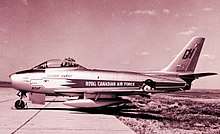
In April 1960, Garrison and Harradence became a founding directors of Monarch Savings & Trust, Ltd., the last financial institution of its type chartered by the Province of Alberta. In 1963, Garrison took time away from flying to coordinate Roy Farran's successful campaign for a seat on Calgary City Council.
In 1982, Garrison created The Haitian Children's Fund, a charity to focus on the needs of Haiti's young. During the 2004 Gonaïves hurricane disaster, Garrison coordinated all container donations into Haiti for Prime Minister Gerard Latortue's government.
During 1989–1992, Garrison operated The Yellow Bird – Galerie d'Art Haitien, a Santa Monica art gallery specializing in Haitian art.
Film projects
In 1980, as producer and director of a television series on the paranormal, Garrison set out to film the secrets of Voodoo, accompanied by Burt Lancaster and Samantha Eggar. During an effort to dig up a buried zombie in a cemetery of Desdunes, the team was almost killed by angry peasants.
In 1990, Garrison collaborated with Lou Lenart, who had led the first Israeli Air Force attack in May 1948, on First Strike, a feature film based on Israel's Operation Babylon, the 7 June 1981 attack on Iraq's Osirak nuclear plant. Garrison re-wrote the script and was set to direct the aerial sequences.
In 1994–1995, Greystone Communications Group gained access to all Russian wartime footage. They planned an aviation series for the History Channel and retained Garrison and Bill Casale to develop the concept. While Garrison was intended as a team leader, the project was delayed until 1996 and Garrison moved on to other projects.
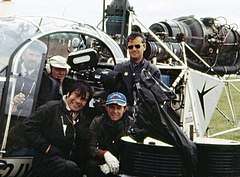
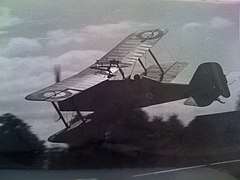
Between 1964 and 1965, Garrison worked with the Irish Air Corps to establish a collection of First World War replica aircraft and support equipment at Weston Aerodrome, Leixlip, Ireland. It was originally established for 20th Century Fox's 1966 film The Blue Max.[12] The aerial fleet included a sole Caudron 277, two Fokker DR 1s, three Fokker D VIIs, two S.E.5As and two Pfalz D IIIs (all full-scale replicas) four de Havilland Tiger Moths, three SV4C Stampes, a Morane 230 and six Curry Wot 3/4 scale S.E.5As.
Garrison and the Irish Air Corps continued their relationship, the latter providing aircrew and engineering staff to support Garrison's media work through to the late 1970s. Garrison was responsible for coordinating the first Marchetti SF-260 Warrior demonstration at Baldonnel, leading to the Corps acquiring several Warriors. He partnered with James Baring, heir to the Barings Bank estate and a demonstration pilot who flew in a number of Garrison's film projects, along with John Fairey, of the Fairey Aviation family. Garrison established new techniques for obtaining aerial footage, creating new camera mounts and special effects. The Irish Film Act of 1970, which provided favourable tax facilities for film productions and resident foreign creative individuals, was the result of a collaboration between Irish Prime Minister (Taoiseach) Jack Lynch and Garrison.


Garrison supplied the airfield, equipment and personnel for the Roger Corman movie, Von Richthofen and Brown. He directed the aerial sequences and flew the camera aircraft, a Helio Courier. On 15 September 1970, Charles Boddington, a veteran of The Blue Max and Darling Lili shoots, was killed when his S.E.5 spun during a low-level maneuver. The following day, on the last scheduled flight of shooting, Garrison and actor Don Stroud were involved in a low-level sequence in a Stampe-Vertongen SV.4, when a jackdaw struck Garrison in the face, knocking him unconscious. The aircraft then ran through five power lines, snap-rolled and plunged into Lake Weston. Garrison and Stroud were rescued, Garrison sustaining a head wound requiring 60 stitches.
During the September 1970 filming of Owen Crump's film, Zeppelin, Garrison's unit lost an Alouette helicopter and S.E.5 in a mid-air collision over Wicklow, Ireland with a loss of five people including Burch Williams, brother of 20th Century Fox executive Elmo Williams. For the film Tora! Tora! Tora!, Garrison and Jack Canary created the large fleet of "Japanese" aircraft. Some of these aircraft still make appearances at air shows.[13] Garrison also worked on Darling Lili, Barry Lyndon, Ryan's Daughter and the TV series "Twelve O'Clock High".
In 1981, Wakusei Robo Danguard Ace (惑星ロボ ダンガードA(エース) su?) was a Japanese science fiction anime series created by Leiji Matsumoto. Garrison wrote the English dialog for its re-dubbing.
Mercenary activity
Garrison became a mercenary, flying as a combat pilot in various conflicts and later acting as a military and political advisor, allegedly with the support of several US Government agencies and U.S. senators.
During the Nigerian Civil War (1967–1970), Garrison joined a group of mercenaries fighting for the breakaway state of Biafra.[14] Garrison was originally dispatched to Biafra to research ways to neutralize the Nigerian Navy frigate Nigeria, which was blockading Port Harcourt to disrupt petroleum exports. Discovering his expertise as a pilot, the Biafrans asked for Garrison to assist. On 20 August 1967, he flew one mission in an almost unserviceable B-26 against Kano airfield, destroying three Mig-17s. Then it was realised that light aircraft could operate as simple COIN platforms, gaining the support of Garrison's associates, James Baring and John Fairey, of the Barings Bank and Fairey Aviation Company families. Count Gustav von Rosen initiated this concept, which finally sas action in May, 1969. Garrison's RCAF experience help him destroy numerous Soviet-supplied aircraft, such as a MiG-17 and IL-28 at Port Harcourt on 22 May 1969. Numerous such raids were conducted around this period.[15]
Operation Tiger Claw was a military conflict fought in late October 1967 between Nigeria and Biafra. On 17 October 1967, Nigeria invaded Calabar, led by Benjamin Adekunle, while the Biafrans were led by Col. Ogbu Ogi, who was responsible for controlling the area between Calabar and Opobo. The Biafrans came under fire from the water and the air. For the next two days, Biafran stations and supplies were bombarded by Nigerian warplanes. Upon arrival in Calabar as a mercenary, Garrison came under fire by federal troops. By October 20, Garrison's forces withdrew from the battle while Ogi officially surrendered to Adenkule.
In May 1969, Carl Gustaf von Rosen formed a squadron of five Malmö MFI-9 MiniCOIN piston-engined aircraft, armed with rocket pods and machine guns, known as the Babies of Biafra, which attacked and destroyed Nigerian jet aircraft on the ground and delivered food aid.[16] Garrison coordinated the attacks, destroying an Ilyushin Il-28 bomber and a Mikoyan-Gurevich MiG-17 fighter during the first attack against Port Harcourt airfield on 22 May 1969. Over the following week, he led attacks on Benin airfield and Enuga airfield to neutralize the Soviet-supplied jets and to put the Ughelli Delta One power plant out of action. The operation effectively neutralized the Soviet-sponsored jet element, changing the balance of power.
During 2017, an American intelligence study investigating light COIN aircraft contacted Garrison regarding the Biafran action.[17][18] In response, Garrison provided details on his combat experiences in the conflict.[19] Each year, on 30 May, the IPOB - Independent People of Biafra - hold the Biafran Annual Remembrance Day; Garrison's role has often been noted. The 2018 remembrance activities were marked by publication of articles, one entitled: "Biafra Fallen Heroes: The Heroic Deeds Of Lynn Garrison In Focus".[20][21]
Later in 1969, Garrison flew in the last military conflict involving propeller-driven fighters (P-51 Mustangs and the Vought F4U Corsairs) during the Football War between El Salvador and Honduras.[22]
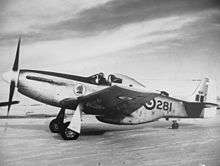
Garrison had owned an ex-French Navy Corsair which had operated in Vietnam and during the 1956 Suez Crisis, having bought it after its retirement from French service, it was transported to California for him with help from the U.S. Navy.[23] It was used in the TV series Baa Baa Black Sheep. Garrison performed many low-level aerobatic displays in the Corsair as a private operator. Garrison was retained by LTV Aerospace president Paul Thayer to do a Bob Hoover aerobatic show to promote Vought's new fighter, the LTV A-7 Corsair II, but the idea was dropped due to insurance requirements.
Haitian activities
By August 1991, Garrison was back in the political arena and, arguably, a military role as a personal advisor to Haiti's military ruler, Lieutenant General Raoul Cédras,[24] the US Senate and, allegedly, the DIA and CIA.[25] He acted as the interface between the American embassy and Cedras after diplomatic relations were severed; his code name was "'The Shadow".[26]
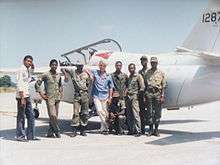
In June 1992, Garrison, working with Colonel Pat Collins, the Military Liaison Officer with the American embassy, wrote a White Paper visualizing modification of the Forces Armeés d'Haiti (FAdH) into what they called, an Army of the People. This would see the FAdH undertake many projects to support Haiti's population, including road building, school and hospital construction, revival of the nation's 23 airfields and interdiction of drug traffic from Central and South America. Mobile medical/dental clinics, staffed by military personnel, were to be a major factor in the program. A team of 700 Canadian and American military engineers and technical staff was dispatched to Haiti on the USS Harlan County, on 11 October 1993, but left Haitian waters when its captain, Commander Butcher, perceived dangers not seen by Colonel J.T.F. Pulley, 7th Special Forces chief on board.[27][28]
During his three years with the Haitian military, Garrison managed to defuse several potentially disastrous situations. Perhaps his most important act was the key role he played in derailing President Clinton's planned invasion of Haiti, during September 1994, to return exiled President Jean Bertrand Aristide. Prior to the American occupation of Haiti, Operation Uphold Democracy on 19 September 1994, the borders were sealed and air traffic suspended. Garrison's friend, journalist Colonel David Hackworth, one of America's most decorated war heroes, and author of the best-selling book About Face, wanted to cover the Haitian situation. Garrison sent someone to the Dominican frontier to bring Hackworth to Port-au-Prince.
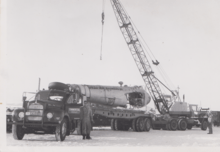
In a final effort to avoid a full scale invasion of Haiti, on September 18, President Clinton sent a three-man team, made up of Jimmy Carter, Sam Nunn and Colin Powell to negotiate with Cedras. The American negotiators used Garrison's office, located adjacent to that of Cedras, as the focal point of their communications with Clinton's team. In his book, ‘Hazardous Duty’, Hackworth recounted the final moments before the invasion, in which Garrison's intercession effectively derailed it with predictions of 25,000 potential civilian casualties.[29]
The return of President Aristide in 1994 promptly led to Garrison being accused of running a public relations campaign against Aristide.[26] Garrison allegedly accused Aristide of ordering the murder of eight political opponents prior to leaving the country.
Retirement

In 1992, Garrison was named Haitian Consul to the United States, an appointment he retained in 2010. Garrison has now retired but is writing a third book: HAITI: Coup de Grace, due for release in the near future. He remains a resident of the United States but has continued to work on the project he created in 1987, the Haitian Aerial Reforestation Project (HARP) to scatter tree seeds by aircraft.
In January 2010, Garrison helped to coordinate the airdrop of food and other aid in the aftermath of the 2010 Haiti earthquake. On 20 October 2010, even as the cholera epidemic was reported in central Haiti, Garrison was on the way to the area with a truckload of re-hydration solutions to combat the epidemic.
Garrison's Haitian Children's Fund is coordinating distribution of donated One World Futbol soccer balls in Haiti as part of a Chevrolet sponsored worldwide project to acquire and distribute containers of these undeflatable balls to Third World countries.[30] President Michel Martelly, a soccer enthusiast, is personally assisting with distribution in Haiti.
Honours
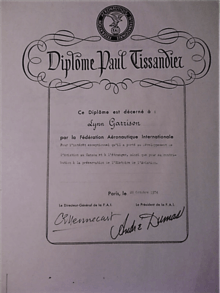
In 1973, Garrison was awarded the Paul Tissandier Diploma by the Federation Aeronautique Internationale for his contributions to world aviation. He was recommended by the Royal Canadian Flying Clubs Association.
Ancestry
Garrison's ancestors migrated from Ireland to Pennsylvania in 1728. Some moved on to Kentucky and then to Marion County, Illinois. Garrison's great grandfather, William Lloyd Garrison, served with the 40th Illinois Volunteer Infantry Regiment during the American Civil War. He lost his leg in the Battle of Shiloh, and was subsequently released from service on 18 October 1862.[31] In 1904, his son, William Garrison, took the family to homestead in Westlock, Alberta, making the 1,500-mile journey in covered wagons. Ivan Garrison, Lynn's father, was born on 22 February 1897 in Enterprise, Illinois. He would serve with the 4th Field Ambulance of the Canadian Army Medical Corps during the First World War, and with the Royal Regiment of Canadian Artillery, during the Second World War. His brother Tim Garrison resided in Prince George, British Columbia, Canada.
References
Notes
- KB976 and Lynn Garrison by Lynn Garrison (TimeFadesAway.co.uk, last updated 10 July 2013)
- Foreman 2003, p. 18.
- Walker, R. W. R. "RCAF Mustangs 9221 to 9250." ody.ca. Retrieved: 8 December 2011.
- Jenkins, Gordon. "115 ATU UNEF." 115atu.ca. Retrieved: 4 October 2012.
- "Alberta's cloud-seeding pilots see 2nd busiest year in 20 years". CBC News. 22 August 2014. Retrieved 23 August 2014.
- "Surviving Lancaster – Air Museum of Canada." lancaster-archive.com. Retrieved: 8 December 2011.
- "Lot 375." bonhams.com. Retrieved: 7 February 2014.
- Cromer, Peter. "The Journey Begins." Calgarymosquitosociety.com. Retrieved: 1 October 2012.
- Ed McMahon. Here’s Johnny. Nashville, Tennessee: Rutledge Hill Press, 2005. ISBN 1401602363 page 167
- Kirshenbaum, Jerry. "Craig Breedlove is the undisputed champion of a sport." Archived 2009-05-04 at the Wayback Machine Sports Illustrated, April 27, 1970. Retrieved: 12 June 2010.
- Rogers, Jolly. "We Remember." Fighterpilotuniversity.com. Retrieved: October 1, 2012.
- "History: Blue Max Triplane." blue-max-triplane.org. Retrieved: December 8, 2011.
- Freedman, John. "Mitsubishi Zero VH-ZRO Tora replica Down Unde r". Australian Flying.com. Retrieved 10 March 2012.
- "The Mercenaries." Time magazine, 25 October 1968.
- Al J. Vetner. “Biafra’s War 1967-1970: A Tribal Conflict That Left a Million Dead.” Warwick, UK, Helion & Company, 2015. ISBN 978-1-910294-69-7. pp. 197-210.
- Gary Brecher. "Biafra: Killer Cessnas and Crazy Swedes." Archived 2008-01-14 at the Wayback Machine exile.ru, 15 October 2004.
- Retrieved: 28 May 2018.
- "BiafraFallen Heroes: The Heroic Deeds Of Lynn Garrison In Focus." Retrieved: 3 June 2018.
- Retrieved: 28 May 2018.
- "Biafra Heroes Remembrance Day: 30th May Sit-At-Home Directive Is Sacrosanct and Morally Right - IPOB." Retrieved: 29 June 2018.
- "BiafraFallen Heroes: The Heroic Deeds Of Lynn Garrison In Focus." Retrieved: 29 June 2018.
- Depner, Wolfgang. "Warfare Without Shooting." Diplomat & International Canada. Retrieved: 7 October 2012.
- Chapman, John et al. "Corsair/BuNo. 133693." warbirdregistry.org. Retrieved: 8 December 2011.
- "AIM Report: Jesse Jackson's Rapid Resurrection." aim.org. Retrieved: 8 December 2011.
- "Haiti." Archived 27 November 2010 at the Wayback Machine PR Watch.org. Retrieved: 8 December 2011.
- Davison, Phil. " 'Shadow' plays dirty tricks in Haiti: A Canadian adventurer is behind the smear campaign against Aristide." The Independent, Retrieved: 8 December 2011.
- Diebel, Linda. "Canadian advises Haiti chief." Toronto Star, 19 October 1993.
- Riehm, LtCmdr Peter. "The U.S.S. Harlan County Affair." Military Review, July–August 1997, pp. 31–36.
- David H. Hackworth. Hazardous Duty. New York, New York: Avon Books, 1996. ISBN 0-380-72742-0 page 236.
- O'Hanlon, Ryan. "The Soccer Ball That Never Needs Air". Outside Online. Mariah Media Network, LLC. Retrieved 11 December 2012.
- Yarbrough, Carol. "Men of the 40th Regiment Illinois Volunteer Infantry." .carolyar.com. Retrieved: 23 September 2012.
Bibliography
| Wikimedia Commons has media related to Lynn Garrison. |
- Garrison, Lynn. Aristide: The Death of a Nation. Fort Lauderdale, Florida: Leprechaun Publishing Group, 2004. ISBN 978-0-9704636-7-8.
- Garrison, Lynn. Voodoo Politics: The Clinton/Gore Destruction of Haiti. Fort Lauderdale, Florida: Leprechaun Publishing Group, 2000. ISBN 978-0-9704636-2-3.
- Garrison, Lynn. EVOLUTION: 90 MPH to Supersonic in 30 years. Portland, Oregon: Bitz Publishing, 2016. ISBN 978-1-4942507-1-3.